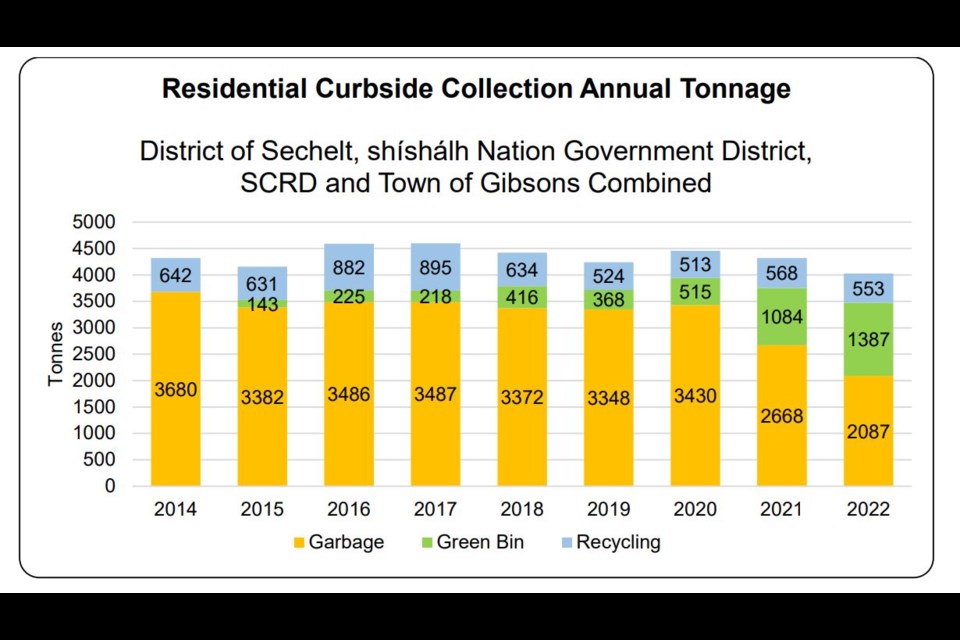Kudos, area residents! On average, each Sunshine Coast Resident sent 49 kg less garbage to the region’s landfill in 2022 compared to 2021 levels. Last year’s individual garbage volume was 372 kg, according to the Sunshine Coast Regional District’s (SCRD) annual solid waste diversion update.
Yet, per-person garbage volumes remain higher than the SCRD’s target of 315 kg per year or less the update, which is to be presented at the July 27 committee of the whole meeting, notes. The document points out that getting to a lower volume of garbage, a goal in the region’s 2011 Solid Waste Management Plan is also taking longer than planned. The plan aimed to achieve an annual per capital garbage level between 279 and 315 kg six years earlier, in 2016. While progress has been made since the regional district set that goal in 2011 (when each Coaster put about 420 kg into trash bins), the report indicates a continued need to focus on reducing garbage volumes.
The 2022 update charts the solid waste diversion rate (weight of materials redirected by recycling programs divided by the total weight of waste generated) at 59 per cent, below the 69 per cent the SCRD had aimed to achieve by 2016. In 2011, that rate was at 48 per cent.
2022 garbage numbers
With about 7,000 more people living on the Coast in 2022 than in 2011, the annual volume of garbage from all sources added to the local landfill for each of those two years was nearly the same: about 12,000 tonnes. "The total amount of curbside garbage collected decreased in 2022,” the report states. Trash volumes collected from Coast homes last year were almost half what was being thrown away in 2014. All areas except the shíshálh Nation Government District, saw their garbage volumes dip last year compared to the previous one. Within the Nation’s area, tonnage increased over 2021 levels by five tonnes (to 136).
Commercial and construction garbage volumes, which are not part of local government collection programs, grew over the past four years. A graph entitled “Top Three Materials Disposed Sechelt Landfill” shows that in 2018, volumes of garbage from those contributors were about the same as for residential customers at about 5,000 tonnes each. By 2022, commercial and construction waste had increased to the 6,000 tonne range. With an expanded focus on residential garbage diversion in those years, landfill contributions from construction sites and businesses were more than double household garbage volumes as of last year.
Diversion data
Diversion programs, including the SCRD’s curbside recyclable collections, depots and other options resulted in 17,764 tonnes of discarded materials avoiding the landfill. In 2011, that tonnage totalled 11,085.
Last year, almost equal volumes of recycling and garbage (1,940 tonnes in green and blue bin programs and 2,087 tonnes of garbage) were collected curbside from residences by Coast local governments. In 2014, when the District of Sechelt’s blue bin initiative was the only public curbside recycling in operation locally, those collections weighed in at 642 tonnes, compared to garbage pick-ups throughout all areas of the Coast of 3,680 tonnes.
In 2022, residents of the District of Sechelt recycled more than they threw out, with the annual tonnage of curbside bins for repurposing at 1,089 compared to 781 for garbage. Residential garbage collected within the shíshálh Nation Government District was at 156 tonnes with recycling collections at 54 tonnes. Those jurisdictions have both food scrap and durable recycling (blue bin) collections.
Within the Town of Gibsons and SCRD areas with residential waste pick-up services, only food scraps and garbage are part of the curbside programs. In the Town, last year’s garbage collections yielded 349 tonnes and recycling came in at 247 tonnes. In the regional district, the tonnages were 830 for garbage and 581 for food product compostable collections.
Update on landfill life
The importance of reducing garbage production was underlined in the report, which contained an estimate that the region’s only solid waste disposal site, Sechelt Landfill, will be at capacity by mid-2026.
The regional district has not identified or applied for permitting of a new landfill site. However, options in Area B (Halfmoon Bay) have been proposed and an update to the Solid Waste Management Plan that looks at how to address solid waste in the future is being discussed. The report states, “In 2023 the SCRD received provincial approval to add the temporary export of solid waste off coast to the 2011 Solid Waste Management Plan… should the Sechelt Landfill reach capacity before a new long-term disposal option is identified, approved, and operational, waste export will be needed to ensure the continued delivery of solid waste services.”


